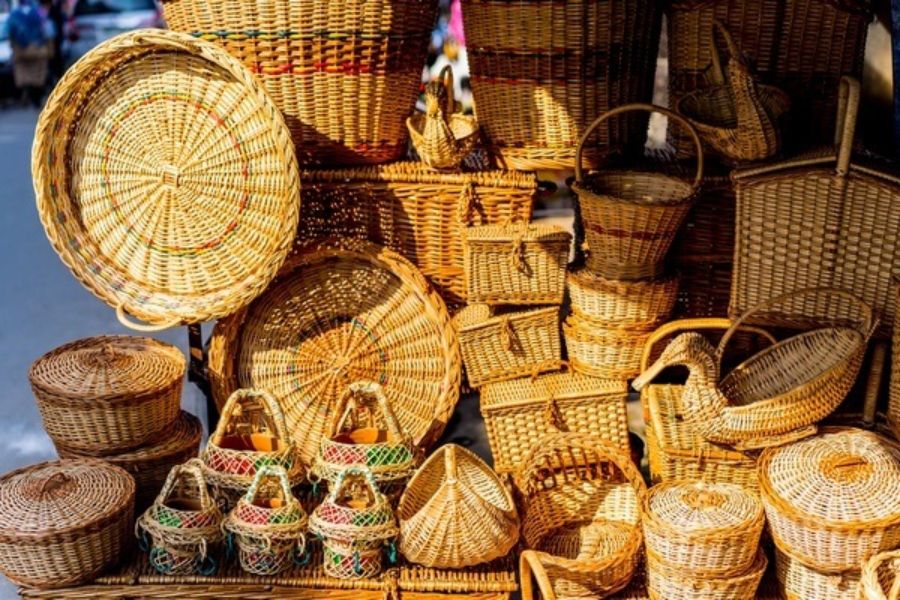5 Exquisite Handmade Ceramic Techniques That Deserve To Be Famous
Vietnamese ceramics boast a rich history, their techniques evolving alongside the Vietnamese spirit. These enduring craft traditions have secured Vietnam's place on the global ceramic stage.
At CHUS, we seek not just aesthetically pleasing products, but those imbued with the soul and cultural essence of Vietnam. Join us as we delve into the world of captivatingly beautiful ceramics, crafted with unique techniques.
Some of the craft techniques to make ceramics
1. Fire glaze ceramics
Fire glaze transcends mere enamelling, embodying a symphony of traditional Vietnamese ceramic artistry. This technique masterfully utilizes iron oxide, titanium, and precise temperature control to create mesmerizing, flowing patterns reminiscent of flames.
The resulting works showcase both sophistication and the boundless creativity of the artisan. Each piece, crafted with meticulous skill and fired at over 1300 degrees Celsius, possesses a unique and unparalleled beauty.

Established in 2006 by Phan Thuy Mai and Francois Jarlov, Dong Gia Ceramics was born with the singular aim of revitalizing milky white cups through the fire enamel technique. Their dedication has brought Vietnamese ceramics closer to a wider audience, both within Vietnam and internationally. Dong Gia's creations not only showcase skilled craftsmanship and artistic excellence but also embody a harmonious blend of Vietnamese nature and cultural heritage.
2. Hand-drawn on cerammics
Hand-drawn ceramics represent a cherished tradition, embodying the artistry of skilled artisans. Each piece is meticulously crafted by hand, resulting in unique variations in motifs, patterns, lines, and a subtle, monochromatic color palette. This inherent individuality imbues each ceramic with a personal touch, making it a unique expression of the artist's vision. Beyond their aesthetic appeal, these hand-painted ceramics transcend mere functionality, becoming vibrant vessels that carry stories of Vietnamese life and culture.

At CHUS, we have Tu Hu Ceramics - traditional Vietnamese ceramics in a modern "look and feel". Although it is a young ceramic brand that keeps up with modern trends, Tu Hu Ceramics still preserves traditional beauty. The hand-painting technique has brought Tu Hu Ceramics products that are crazy beautiful. In addition, the artisans here also apply other techniques such as coloring with thread and spraying color to truly and completely depict all different forms.
3. Glazing technique
Ceramic glaze, a thin glass layer measuring 0.15-0.4mm, is applied to the fired ceramic body. This creates a smooth, glossy, and more durable surface, resistant to staining and enhancing product longevity. Beyond its aesthetic appeal, glazing serves as a canvas for artistic expression, allowing artisans to apply colors and patterns through dipping, brushing, or spraying techniques.

dentifying the glaze on ancient ceramics is crucial for research purposes. This analysis not only reveals the characteristics of the glaze itself but also sheds light on the specific glazing techniques employed. Consequently, accurate glaze identification contributes significantly to understanding and appreciating the value and origin of these ceramic artifacts.
4. Careful carving and engraving techniques
Engraving techniques hold a significant place in the history of ceramics. Notably, the Chinese pioneered black ceramics with engraved details during the Stone Age. These unique designs, featuring deeply carved and hollow lines, were achieved using sharp bamboo chisels instead of modern steel knives.
This technique demands not only skill but also a profound understanding of the craft and cultural traditions. More than mere decoration, the engraved lines serve as a narrative, conveying the story, history, and even philosophical undercurrents of an era. As such, engraving has become a cornerstone of ceramic art and an integral part of cultural heritage across the globe, including Vietnam.

5. Enamel ceramics
Enamel - or Phap Lam Hue, a cultural icon intertwined with the ancient capital of Hue's world heritage status, refers to a unique enameling technique. This process involves applying layers of colorful enamel onto a metal base, often copper, to create beautiful and durable objects.
Inspired by European enameling techniques in the late 17th century, it was adopted in Vietnam under King Minh Mang in 1827. Hue artisans then refined the method, resulting in glazed products boasting distinct decorative motifs and vibrant colors.

These products not only demonstrate the sophistication and talent of the artisans but also show their durability over time. This has helped these products retain their splendid beauty, contributing to the richness and uniqueness of the world cultural heritage of the Ancient Capital of Hue.
The spread and value of traditional Vietnamese ceramic making techniques
Even in a modern context, traditional Vietnamese ceramic making techniques are still maintained and developed thanks to the talent and passion of artisans. We have colorful paintings, intricate patterns on the ceramic surface. This not only reflects the quintessence of national culture but is also a symbol of borderless creativity.

Vietnamese ceramics have soared to international acclaim, carrying the soul and love for the country. They stand out among the world's diverse ceramics, inspiring admiration and immense pride. These art forms not only strengthen cultural identity but also effectively promote the beauty and value of Vietnamese art on a global scale.
Conclusion
While modern technology advances, the value of traditional handmade techniques remains unparalleled in Vietnamese ceramics. These time-honored methods continue to breathe life into contemporary pieces, embodying the essence of Vietnamese artistic expression. Join CHUS as we explore the enduring legacy of Vietnamese ceramic craftsmanship.








